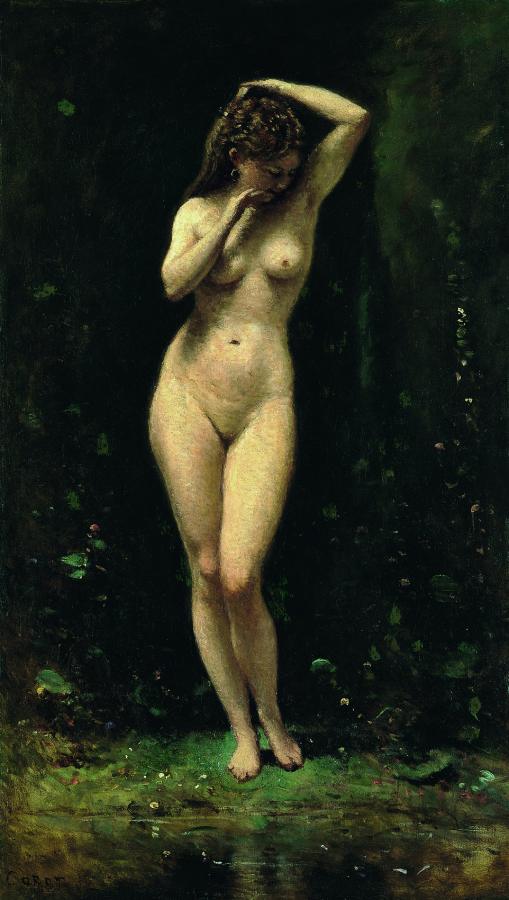Corot, Jean-Baptiste-Camille (1796-1875)
Le Bain de Diane, La Fontaine (Diana Bathing, The Fountain)
1869–1870
Oil on canvas, 72.1 x 41 cm
Museo Thyssen-Bornemisza, Madrid
©Carmen Thyssen Collection
According to Alfred Robaut, Corot painted this work between 1869 and 1870 in the company of Achille Oudinot (1820-1891).
Little is known about the painter Oudinot, a pupil and friend of Corot‘s, capable, at his best, of equalling his master; however, he remains largely unknown, and most of his works are kept in the United States. The note “painted in the company of Oudinot, ” found in different versions in the annotated catalogue edited by Alfred Robaut and Etienne Moreau-Nélaton, can be interpreted in different ways; its meaning depends entirely on the context. Does it mean that Oudinot was responsible for a particular section, or did he simply paint the same subject in the company of Corot? In that case, it is to be supposed, if we take into account the habits of both artists, that it refers to a life-drawing session done together, each one painting his own work.
Naturally, Corot is better known as a landscape painter, often associated-a little too quickly-with the Barbizon School, than as a painter of nudes. This aspect of his art was probably one of the revelations of the retrospective exhibition of 1996 held in Paris, Ottawa and New York, even though he only painted around thirty nudes, only of women, most of which are kept in public collections.
Thanks to Robaut we know that Emma Dobigny, one of Corot‘s favourite models, posed for this Diana Bathing. She was also known for doing some modelling for Puvis de Chavannes and Degas. Corot depicted her in many of his works, the most famous being Lady in Blue (Paris, Musée du Louvre) and appreciated in particular her vitality, while other artists criticised the fact that she could not keep still.
The rather un-anatomical style of Corot‘s nudes puzzled many of his colleagues, including Ingres. On the other hand, Hippolyte Flandrin found that Corot expressed something he did not find in his contemporaries. Fortunately, Corot explained his views on this subject, something he did rarely, referring to The Toilette, Landscape with Figure (Private Collection), undoubtedly one of his most beautiful compositions of this type: “You can see the effort I put into hiding the joints between the collarbones and the sternum, or into blending the contours of the ribs, just visible at the base of the breasts; I try to proceed differently from what is usual, that is, by showing first and foremost that I know what I am doing. Since this is not a lesson in anatomy, I have to blend, like nature does, the cover of the frame which makes up and supports the body, in order to render only what I feel in front of this flesh, through which one can see the blood running underneath, while at the same time it reflects the light of the sky. In one word, I have to put into painting those breasts the naivety I would put into painting a milk tin.” These words explain beautifully, without the need for further commentary, how Corot manages to introduce emotion and poetry into such an apparently banal painting.
For the sake of completion, it should be mentioned that there are three very similar works. The first, housed in the Pushkin Museum in Moscow, is a wider and brighter composition. The model is presented in a very similar position, in a wooded landscape; her right hand is bent towards her right cheek with a graceful movement. Two young women can be seen in the background, to the right. One is sitting, with her naked back turned towards the spectator; the second, who is facing us, is almost squatting. The painting from the Carmen Thyssen-Bornemisza Collection could be a study for this work of a larger size. The other two paintings are kept in private collections.
Gérard de Wallens (T-B)
